
Flying smarter The smart airport and the Internet of Things
15 minute read
01 July 2019
As airports become more digitally connected, the Internet of Things (IoT) can open up a world of opportunities. Much more than merely improving efficiency, IoT can transform the traveler experience and generate new revenue.
Digital technology seems to connect everything today. So it is perhaps no surprise that airports—the infrastructure that helps billions of travelers connect across the globe each year—are themselves becoming more digitally connected. The connected, or smart, airport brings together a variety of technologies through the Internet of Things (IoT), with the goal of strategically differentiating an airport, including via improved traveler experience, and tapping into monetary benefits through greater efficiencies and new revenue streams. Achieving this end goal requires significant collaboration between stakeholders, and airports should carefully craft implementation strategies that aim for incremental quick wins over “big bang” transformations.
Learn More
Explore more from the Government and public services collection.
Subscribe to recieve related content
Download the Deloitte Insights app
While awareness of IoT across the aviation ecosystem is high, its knowledge of how to harness and maximize IoT’s capabilities within an organization is much lower. In our survey of the industry, only 12 percent of airport representatives reported that their organizations are very prepared to benefit from IoT applications, and another 10 percent felt that they were not even exploring IoT yet. So if they want to create the connected, smart airport, the logical starting point is by beginning with the basics of what IoT is.
Methodology of this study
Funded by the Airport Cooperative Research Program of the Transportation Research Board of the National Academies of Sciences, Engineering and Medicine, researchers from Deloitte and Texas A&M Transportation Institute produced a primer on smart airports and IoT.1 In the context of this report, the term “airport” is not limited solely to airport operators, but refers to the complex network of stakeholder interactions that goes into getting aircraft safely in the air and travelers and cargo comfortably to their destinations.
The report drew on a variety of research methods including:
- Literature review. The research team reviewed existing academic, business, and technical literature on IoT’s background, concepts, technological architecture, and value propositions. The team also reviewed lessons learned from IoT applications outside an airport environment.
- Stakeholder interviews. The team conducted 18 interviews with industry stakeholders representing IoT experts, airports, airlines, aviation industry associations, federal agencies, vendors, and intelligent transportation system/transportation providers.
- A stakeholder survey. The team conducted an online survey of 103 industry stakeholders representing airports, airlines, airline vendors, aviation industry consultancies, IoT suppliers, and other consulting organizations.
- Case studies. The research team conducted 11 case studies, eight in an airport environment and three in other industries.
IoT as a technology architecture
IoT is not a technology itself but rather a technology architecture—that is, IoT is more than the sum of its component parts. IoT is a way of bringing together different enabling technologies in a specific way to do something new. But how exactly do enabling technologies come together to form an architecture? IoT’s architecture is explained conceptually using the information value loop (figure 1). However, perhaps the best way to understand how these technologies come together to create value is through an example from an airport:
- The airport needs to locate its nonmotorized ground service equipment to maintain it more regularly. GPS tags affixed to the equipment function as sensors to create a thread of digital information about the location of a specific piece of the equipment.
- A network of radios communicates that information back to a central server.
- The server aggregates the location of one cart with the location, type, and maintenance schedule for all of the other carts.
- All this data is analyzed together to create a plan for which carts need to be retrieved today and undergo maintenance.
- With that information in hand, workers act, bringing in the right pieces of equipment for maintenance on time.2
When workers use the information created by IoT to take a new action, the digital information has created value in the real world—in this case, allowing for proper maintenance and greater uptime for ground service equipment. Because IoT is an architecture, what is important is not the specific technologies involved but rather the flow of information through the steps of the information value loop. Since that information can be about anything, the exact amount and type of value created by IoT are limited only by the business problems airports need to solve.
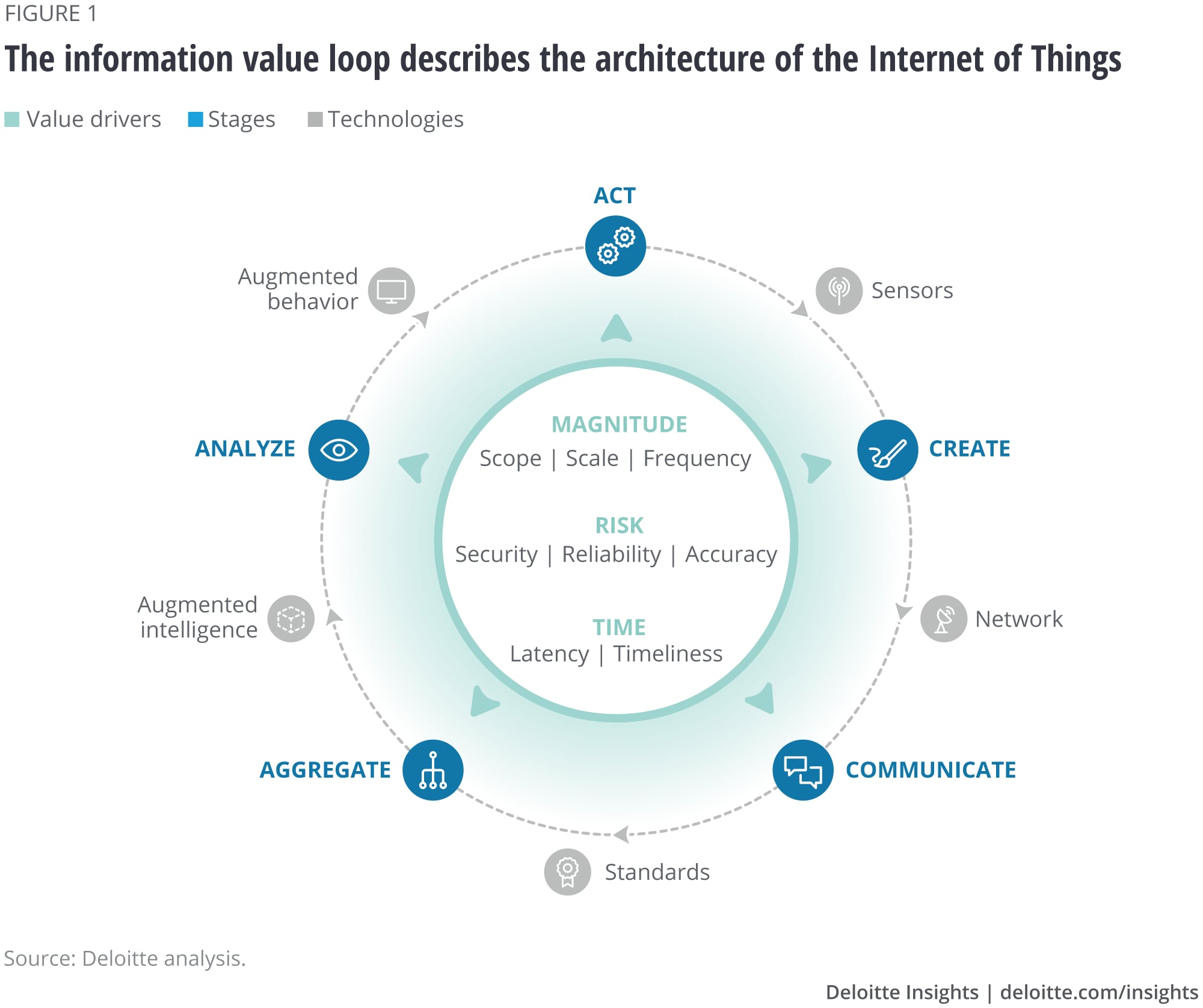
Potential benefits of IoT applications
We see three principal classes of benefits from IoT, and, in selecting the IoT capability or set of capabilities that are “right” for them, airports should consider their goal(s) for IoT implementation:
- Operational efficiency;
- Strategic differentiation; and
- New revenue.
IoT is already in use in airports in many different ways, such as in traveler information systems, traveler traffic monitoring, baggage systems, and facilities management. Most of these uses focus on increasing efficiency. Other uses of IoT, such as enhancing security effectiveness, can improve both efficiency (maintaining throughput with fewer machines or staff) and differentiation (shorter and faster lines for a better traveler experience). Finally, still other use cases can directly generate new revenue such as the use of geofencing to gather fees from rideshares. As a result, these three categories help us understand what IoT can achieve at an airport.
Operational efficiency
The majority of current airport uses of IoT focus on operational efficiency. For example, an airport representative shared that one airport has “a new online inspection system that uses a tool provided to maintenance grounds crew and connected to the Internet with GPS functionality. The purpose of this tool is to digitally connect maintenance crew inspection findings to a map of the airport grounds.”3
Another airport is planning a smart bathroom pilot test. The airport will install IoT sensors on various bathroom assets, including faucets, toilets, lighting, soap dispensers, air fresheners, toilet paper dispensers, and other equipment, in one of its busiest bathrooms. These sensors will transmit data to facilities management to alert it in real time of various shortages and breakdowns. As part of this pilot, the bathroom will have a people counter and a customer input button to capture perceptions of bathroom cleanliness, which will enable facilities management to gauge perceptions of cleanliness against actual use. This may enable greater efficiency for maintenance staff while also providing a better traveling experience.
The long-term horizon for IoT applications supporting efficiency at airports may include autonomous vehicles, tenders, and baggage carts. If integrated with other data sources such as schedules, push-back times, and gate numbers, this data could fully automate a tarmac where robots and autonomous vehicles deliver baggage, fuel planes, clear debris, and perform other tasks—all faster and to closer tolerances than human workers. The result would be that airports could conduct surface operations more efficiently, allowing more flights in and out of the same physical ramps and taxiways. While something like the fully automated tarmac is still years away, the technology needed for such uses is already in action on roadways today.4
Strategic differentiation
While gains in efficiency can be significant, airports that use IoT can also provide a more differentiated product or better customer experience than nonsmart airports. However, differentiation can be much broader, especially for airports where the greatest competition comes not from other airports but from other modes of travel. For example, limiting greenhouse emissions, reducing noise levels over neighboring areas, or even responsibly maintaining an airport’s open space can all be differentiators that make the airport an attractive brand as well as an integral part of the community. In fact, smart products used as part of IoT can even gather information about customer preferences, providing a deeper understanding of what does and does not differentiate travel options.
Differentiation is often a watchword for advertising or customer experience, but it is actually much more. Differentiation is fundamentally about how an airport provides distinctive value to important stakeholders—stakeholders that include groups that range from airlines to travelers to retail tenants to local communities. Differentiation can underpin and support the brand of an airport. IoT applications that support differentiation can come in many different varieties, aimed at traveler satisfaction or even environmental causes. For example, Heathrow Airport set the goal of reducing nitrogen dioxide emissions to help improve local air quality. The airport realized that a major—and avoidable—source of ground-level nitrogen dioxide emissions is aircraft parked at the gate that use auxiliary power units (APUs) instead of plugging into the power grid. As a result, Heathrow Airport deployed an IoT solution to help improve air quality. Microphones positioned around the apron pick up the telltale sound of APUs running. These data are cross-referenced against schedules and other data to determine whether an aircraft is running its APU instead of using the power grid. The airport can then share this data with airlines and remind aircraft to plug in and switch off the APU—not just saving money for the airline but also improving local air quality for all.5
New revenue
IoT can also create new sources of revenue. This can come from creating new products or services to attract new customers or by using IoT to sell more to existing customers. While IoT solutions aiming to generate new revenue are often the largest and most complex, they can also build upon existing solutions that generate efficiency gains to help ease implementation. Our interviews with subject matter experts indicate that airport stakeholders do see the value in such uses and may pursue them in the future. Use cases being investigated include variable rates for advertising and off-airport transit recommendations personalized to an individual traveler. However, because these revenue-generating use cases may involve the greatest number of stakeholders, they are often the hardest to pursue.
That said, just because use cases that create new revenue are hard to create does not mean that they have to be technologically advanced. One airport used Wi-Fi access points as sensors to measure the location and dwell time of people as they moved through the terminals. Armed with this data, the airport was able to put signs and advertising in places most likely to be seen by the right people. So while earlier, very few sales were made to landing travelers, this airport was able to place signs for the products those travelers may want to buy before departing the airport where they would be likely to see them. The result was increased sales to a previously untapped group for retailers, and through them, increasing the airport operator’s landside revenue.6
Trends in IoT adoption
Industries generally have a typical development progression with IoT. The expected benefit of an IoT application varies with the scope, and therefore difficulty, of the project. As a result, most industries begin by pursuing small-scope IoT projects aimed at efficiency since these can often be managed entirely within an organization. Therefore, in most industries, IoT applications aimed at efficiency are the most common, followed by differentiation and then new revenue.
In one recent survey, 34 percent of companies—the top response—said they anticipated gains in efficiency from IoT technology.7 On the other hand, only 6 percent—by far the lowest response—anticipated realizing new revenue thanks to IoT technology. Another survey of companies already using IoT found similar results: 52 percent used IoT to improve efficiency versus 40 percent that used customer-facing IoT applications for differentiation and generating new revenue.8
Overall, airports follow these trends in IoT adoption as well. In our survey, 76 percent of respondents using IoT indicated they used it for efficiency/optimization, compared with 58 percent for customer experience/differentiation and only 35 percent for new revenue.
However, while many airports may follow the typical IoT development trends (moving from efficiency to differentiation to new revenue), unique forces in the aviation industry also open other pathways to IoT adoption. The aviation industry has traditionally set a very high standard for traveler experience, with leading airports designing truly tailored experiences that reflect not only the bespoke expectations of their global travelers, but the uniqueness of the local region as well. Therefore, while IoT applications that improve traveler experience at an airport may be more difficult to implement than those dealing only with internal efficiency, airports may find it easier to begin with differentiation and move to internal efficiency. As aviation entrepreneur and indoor mapping expert Jack Loop puts it:
"Very often, [airports] begin with the consumer-facing side. Consumer-facing projects need to meet a higher bar of usability, so it is actually easier to take a slick consumer-facing project and use it internally than it is to take a purely functional internal tool and bring it up to consumer-facing standard.9"
So while past IoT developments may have focused on efficiency, as airports develop future IoT solutions, they may tend to skew more toward differentiating the airport by improving traveler experience. These sentiments were echoed by other interviewees from airlines and airports, who indicated that future IoT plans were largely focused on improving customer experience.
How IoT creates value for airports
As we saw, airports can use IoT to improve efficiency, differentiate their strategy, and generate new revenue. These benefits of IoT can be applied to any aspect of airport operations. Since airport operations are typically split into two, air side and land side, we will explore how IoT can impact both below.
The traveler experience
IoT can be applied at every stage of a traveler’s journey from arrival curb to gate (figure 2). For example, IoT way-finding applications could be relevant at the parking and arrival stage and the check-in stage. Figure 3 maps common IoT solutions to each stage as well as the airport stakeholders involved in the implementation.
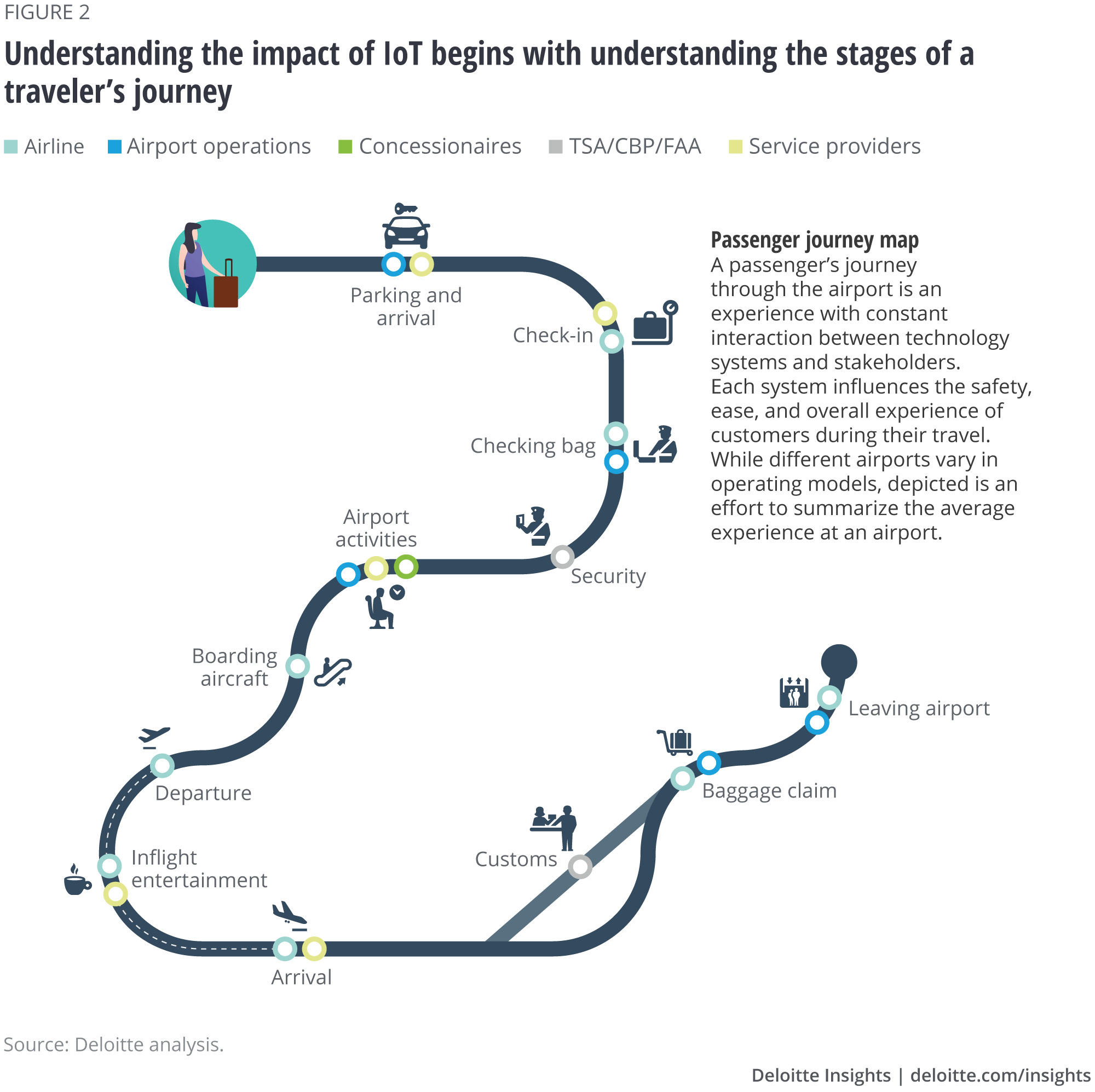
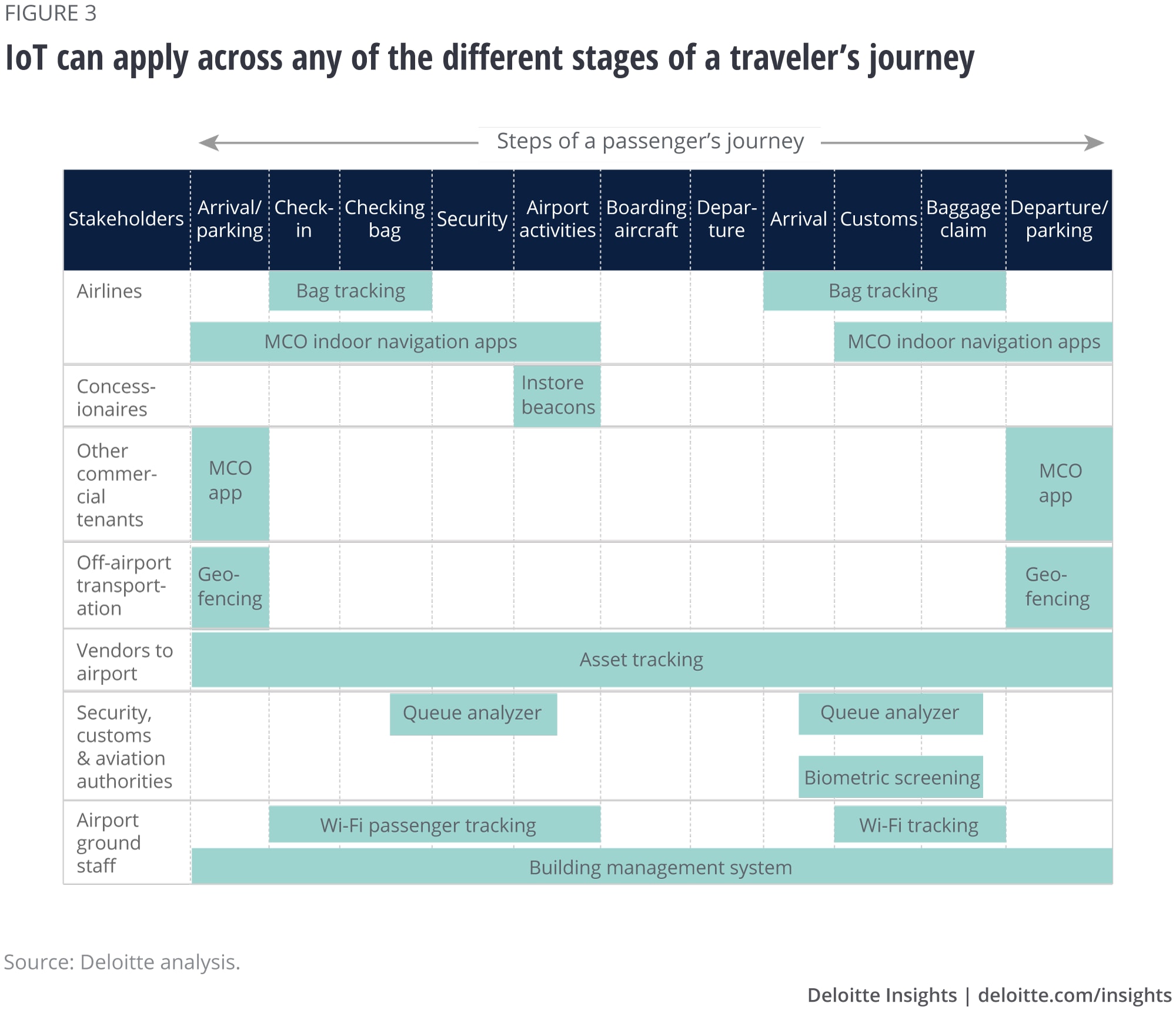
Airport operations experience
Much like a traveler’s journey, operations at an airport can also be seen through the lens of an aircraft’s journey from arrival to departure (figure 4), and IoT implementations can similarly be mapped across each stage and the stakeholders involved for each stage (figure 5).
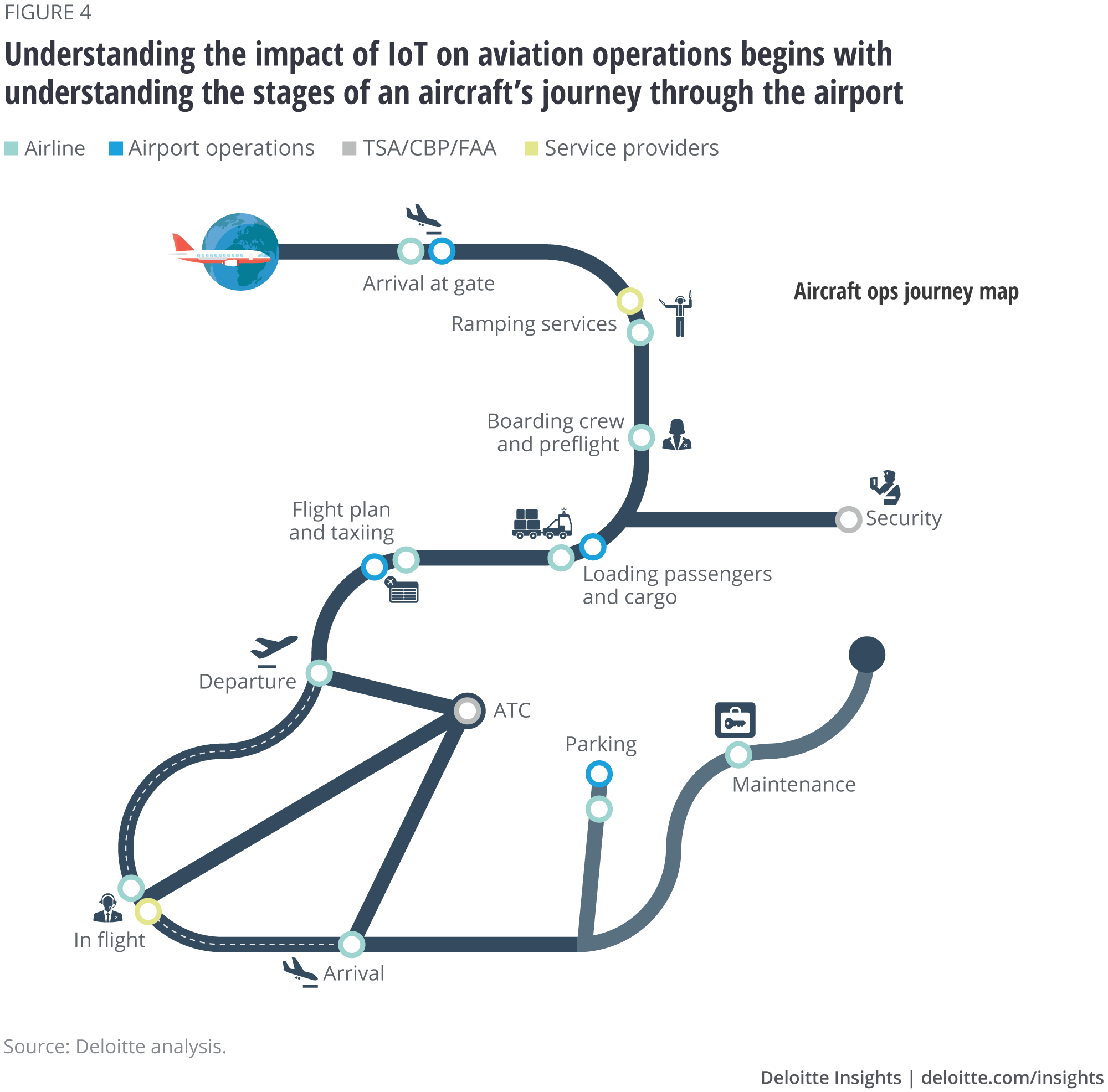
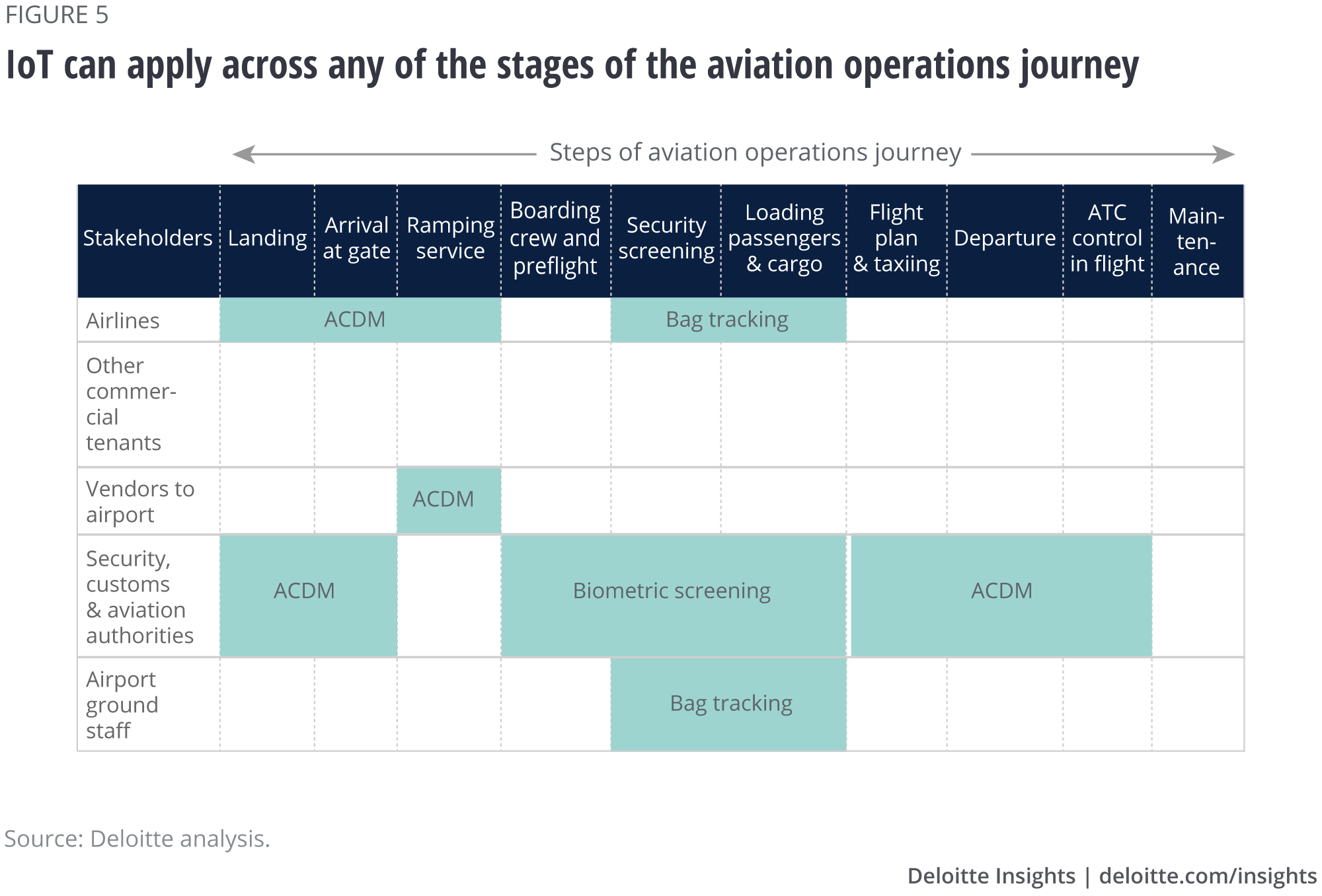
Creating the smart airport
With so many technological options, IoT can quickly overwhelm even the most tech-savvy managers. However, a structured planning process can help airport leaders navigate all the options and gain confidence that the end result will support the airport’s business goals.
Implementation checklist
- Select IoT solution that supports your business goals
- Determine the technical and organizational maturity needed to successfully implement the chosen solution
- Assess your current technical and organizational maturity
- Craft an implementation road map to address the gaps between current and needed maturity
The process begins with selecting a potential IoT project. This can be done with either a top-down approach or a bottom-up approach.
A top-down approach to IoT selection
Based on the goals in their strategic plan, airports should select the right set of IoT capabilities. Different goals for an IoT solution can often call for radically different technology and organization to support them. As a result, the overall strategic goal for IoT drives the infrastructure requirements needed for a successful IoT implementation.
A bottom-up approach to IoT selection
Airports can also identify promising IoT opportunities by examining the existing IoT solutions— or, if there are no true IoT solutions, the existing sources of data—currently operating in their airport, and then identifying areas where these solutions can be extended across or beyond the airport to further meet the airport’s strategic goals. This exercise also shows where other stakeholders may have data or expertise that can help an airport achieve its goals.
The result should resemble a matrix of IoT applications, stakeholders, and the impacted stages of traveler or operations journey, as depicted in Figures 2, 3, 4, and 5. As in the top-down approach, this assessment of the infrastructure requirements for an IoT solution can help the airport gauge the feasibility of a project. However, the map created by the bottom-up approach has an additional benefit: It can help identify other stakeholders who may be able to provide some of the capabilities needed—in effect accelerating an airport’s IoT project adoption by tapping into existing tools or infrastructure.
The capability gap assessment
Whether using the top-down or bottom-up approach, airports assess their overall digital maturity versus the desired end state of a successful IoT implementation.
This assessment should include at least the following criteria:
- The data (size and complexity), communications, and infrastructure required for the potential solution(s) versus what the airport already possesses;
- The cost of the solution itself versus available funds; and
- Stakeholder groups that can achieve benefits from the potential solution versus the security/privacy procedures that must be in place to secure their cooperation or use.
Assessing potential IoT solutions against these qualifiers can confirm (or disprove) the overall fit of that solution for the defined needs of the airport before moving to implementation. More importantly, the gaps between required and current capabilities in each of these criteria can guide the first steps to developing an implementation road map as airports pursue digital maturity (figure 6).

Barriers to IoT implementation
Even with all the right tools and information, implementing IoT solutions can be a significant undertaking filled with new challenges for even the most digitally mature organizations. We look at some of the broad challenge areas below.
- Safety, security, and privacy. In the aviation industry, safety is an inviolate standard. No new technology, no matter how efficient or cost-saving, can be introduced if it compromises safety. When physical objects are connected digitally, the compromise of digital data can have real-world consequences. Therefore, as IoT gains in adoption, safety, cybersecurity, and data privacy are all increasingly linked.
- Technology and infrastructure. Large IoT implementations involve numerous, disparate systems and devices, which all need to connect and operate together. Very few out-of-the-box IoT solutions for airports are currently on the market. This can make it hard to figure out what is needed to support an IoT ecosystem.
- Talent. As IoT gains wider adoption, the roles and responsibilities of airport employees may change as they have more interaction with technology. To keep up with this trend, airports should prioritize addressing talent and skill gaps by implementing training programs for existing employees, expanding hiring for new technical roles, and changing the way leaders manage and organize work groups.
- A compelling business case. In every industry, concerns about return on investment (ROI) are among the top barriers to implementing IoT. Both upfront and continuing costs can vary widely, depending on the specific IoT application. Since IoT has few test cases, the ROI for any IoT investment is not fully certain, with the result that cost can quickly become a deterrent. However, careful consideration of the factors that drive costs and ROI in IoT can help leaders narrow down options and structure their decision-making.
- Funding and financing. Even with a solid business case that promises a clear and acceptable ROI, airports can struggle to find the upfront funding needed to begin a project. Given the thin margins of many airport operators, finding extra dollars to finance an IoT project can induce fear in any airport executive. Taking a structured approach to understanding funding and financing options by asking question about the goal, timeline, and stakeholders involved in a project can help reduce uncertainty and encourage adoption of IoT.
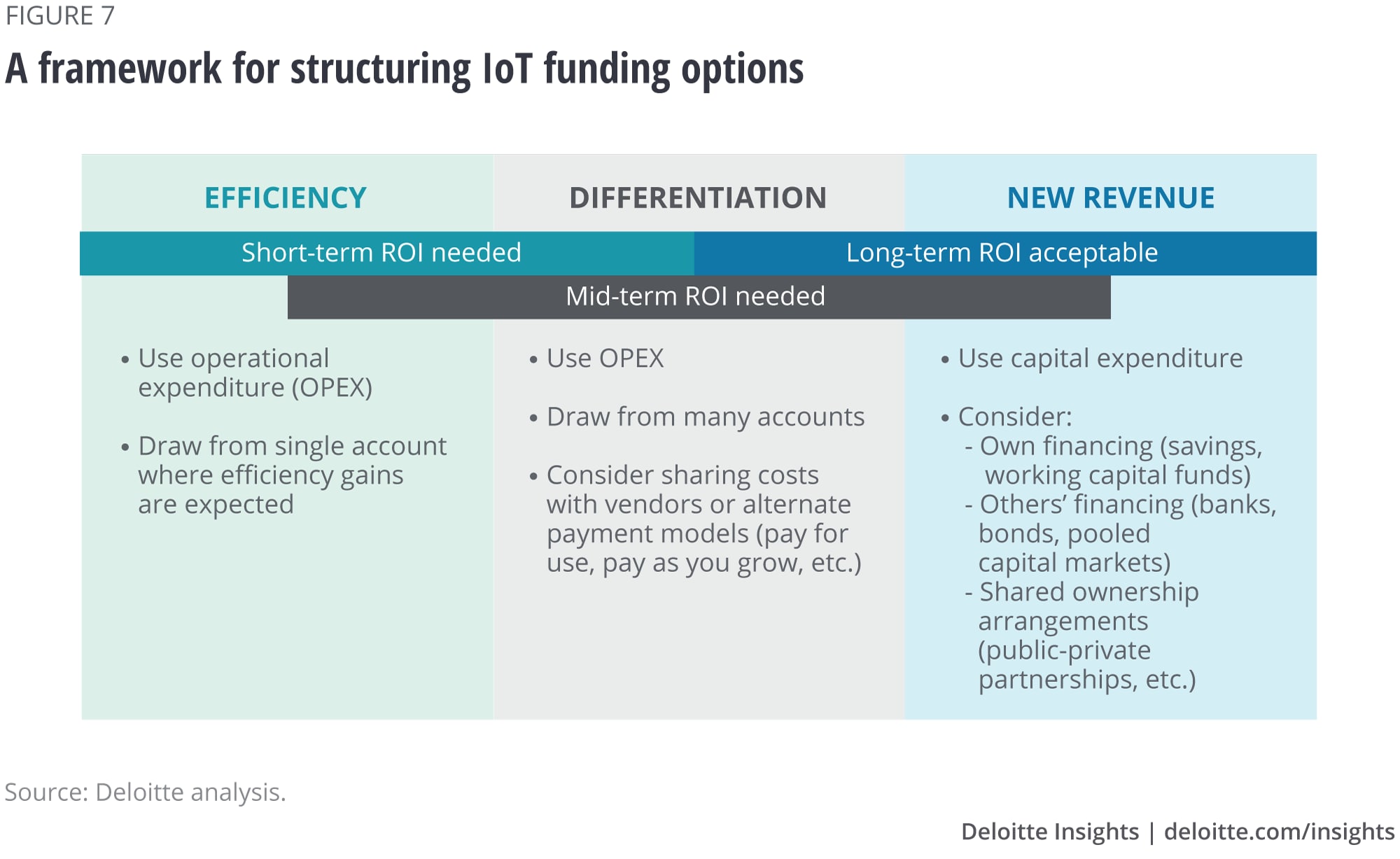
Every IoT solution is unique and, therefore, the funding needs of each solution are likely to be unique as well. But there are a few variables common to every project that can help airports think through which types of funding or financing may be most applicable (see Figure 7 for one example):
- Goal. What is the goal of IoT solution? How will success toward that goal be measured?
- Size of investment. What is the upfront investment required for IoT? What are the recurring costs?
- Timing of return. When can an airport expect a return from an IoT solution?
- Where costs and benefits accrue. Do benefits from IoT help one segment of the organization while the costs must be borne by another?
Overall, barriers to implementing IoT solutions can seem overwhelming. However, with the right team, a thoughtful plan, and supportive buy-in, airports can use IoT to create a better, more profitable operation.
Flying into the future
Regardless of the technology or application involved, IoT can have the biggest impact on airports when the technology is incorporated into the core business model. For example, IoT might be used to facilitate a seamless door-to-door experience for air travelers: A single platform that can order and pay for rides on rail or taxi, handle travel documents, and order additional services could open up entirely new business opportunities for airport operators currently dependent on retail sales and parking receipts and greater customer interaction for airlines and other stakeholders. This mobility-as-a-service approach is exactly the type of IoT-based new business model that could deliver a new future to airports. Other opportunities may include biometric check-in, variable services or prices based on wait times, and individualized boarding processes.
However, only time—and the detailed picture that IoT data can create—will tell what the future holds.10
Learn more about smart cities
-
Smart cities Collection
-
Forces of change: Smart cities Article7 years ago
-
Making cities smarter Article8 years ago
-
Deloitte City Mobility Index 2020 Collection4 years ago
-
Delivering the digital city Article
















